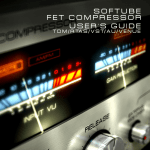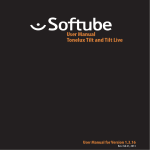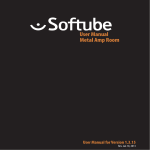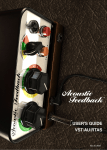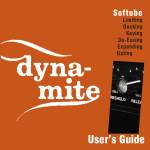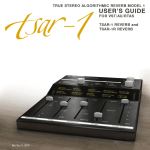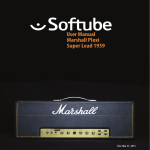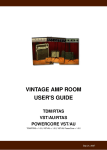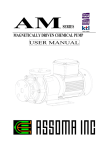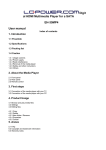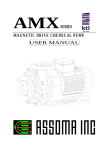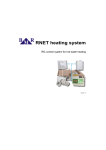Download Softube Passive Attack Pack User`s Guide
Transcript
© 2009 SOFTUBE AB, SWEDEN. ALL PRODUCT AND COMPANY NAMES ARE TRADEMARKS OF THEIR RESPECTIVE OWNERS. AMP ROOM IS A REGISTERED TRADEMARK OF SOFTUBE AB, SWEDEN. SOFTUBE IS A REGISTERED TRADEMARK OF SOFTUBE AB, SWEDEN. ALL SPECIFICATIONS SUBJECT TO CHANGE WITHOUT NOTICE. ALL RIGHTS RESERVED. 2 Table of Contents Contact Details..................................................................................4 Support.................................................................................................................4 Installation and Authorization.........................................................5 Introduction.......................................................................................6 The Trio..............................................................................................7 User Interface....................................................................................8 Key Commands....................................................................................................8 Controls Summary...............................................................................................9 Passive Equalizer............................................................................10 Knobs.................................................................................................................10 Active Equalizer..............................................................................12 Knobs.................................................................................................................13 Focusing Equalizer.........................................................................14 Work flow............................................................................................................15 Knobs.................................................................................................................17 Meters................................................................................................................18 Technical Side Notes......................................................................19 Mono and Stereo Operation..............................................................................19 RTAS on Pro Tools|HD......................................................................................19 Differences Between Passive and Active..........................................................20 Finally, a Note on Modeling...............................................................................21 Buying Recommendations............................................................22 System Requirements....................................................................23 3 Contact Details If you would like to get in touch with Softube, please email [email protected]. Alternatively, you could use the phone or send an oldfashioned mail (do you remember envelopes, stamps and paper?) to: Softube AB S:t Larsgatan 10c SE582 24 Linköping Sweden Web: www.softube.com Email: [email protected] Phone: +46 13 21 1623 (9 am – 5 pm CET) Support On the Softube website (www.softube.com) you will find answers to common questions (FAQ) and other topics that might interest you. Support questions can be posted at http://www.softube.com, where we will help you as fast as we can! Patents This Softube product is protected by patent SE525332 and pending patents US20040258250, EP1492081 and JP2004183976. 4 Installation and Authorization I F Y OU BOU G HT T HE PR ODU C T I N A BOX you will have to register it in order to transfer the license to your iLok account: 1. Go to http://www.softube.com/register to transfer the license to your iLok account. You will need the License Code found in the box, your iLok.com User ID, and your iLok USB dongle. Follow the instructions on the web page. I F Y OU BOU G HT TH E PR ODU C T ONL I NE and have got the confirmation email, the license will already be deposited in your iLok account: 2. Make sure that you have the latest iLok drivers installed. They can be found at http://www.ilok.com. 3. Log on to http://www.ilok.com and transfer the newly received license to your physical iLok dongle. 4. Install the software from the CD, or download the latest version from http://www.softube.com/installers. Sometimes the CD contains installers for all Softube products, but you will only be able to run those that you have acquired licenses for. In some cases, extra demo licenses are included when you buy a Softube product. 5 Introduction TH ER E ARE MANY E QU AL I ZER S out there. Some are extremely advanced with builtin spectrum analyzers and intelligent super modes. Others are simple and nothing more than your average digital equalizer. While some claim to possess super powers, the differences are usually just in the user interfaces, and not always in the sound. Others claim that there is only one way to make a digital equalizer, and therefore every digital equalizer sounds the same. That's not true. Modeling a three band parametric equalizer is more than taking the three separate bands and putting them together. The real electronics interact with each other so that the sum becomes more than its parts, and this sum isn't possible to recreate by stacking up a bunch of standard digital equalizers. We set out to model two vintage equalizers as exactly as possible. The result are the PAS SI VE and ACT I VE E QU AL I ZE R that are probably installed on your computer right now. The A C T I V E is the most traditional of the two. Use it as a standard equalizer and feel comfortable about it sounding the way the real gear does. The P A S S I V E is a bit more quirky but just fantastic sounding. An excellent help when you need that glimmering highend or warm low bottom or je ne sais quoi... If you combine these two, you'll get what we call the F O C U S I N G E QU AL I ZER . It is designed to be a fast and efficient work horse that immediately produces the desired results. The combination of three bands that automatically follows the High and Low cuts and a compressorsaturatordistortionmojomakertool makes it great tool to tidy up and fix your tracks. We hope that you'll enjoy this set of equalizers and that you will find that they are excellent additions to your toolkit that will help you make great sounding music! 6 The Trio This pack consists of three different equal izers. Two of them (P A S S I V E and A C TI VE ) have very diff erent sounds, while the third (F O C U S I NG ) combines these two into a new type of equalizer with a cla ssic sound. We can assure you that there are no other equalizer plugins that sound like these. At a first glance, you will notice that these don't look like your Figure 1: From top to bottom: Passive Equalizer, Active Equalizer and Focusing Equalizer. average equalizer, and at a closer inspection you'll see that the knobs behave in a peculiar way. This is because we have chosen to keep the way the original units worked, and while it feels quirky in the beginning you will get used to it pretty fast. 7 User Interface Handling these equalizers should be easy, and rather than getting acquainted to the user interface you should make yourself familiar with the different sounds they offer. But there are some handy keycommands and mouse tricks that may need explaining... Key Commands • Commandclick (Mac)/Controlclick (Windows): Fineadjust any setting by pressing the Commandkey (the Controlkey in Windows) while adjusting the knob. • Altclick: Reset knobs and switch to their default value by clicking on the knob while pressing the Altkey. Focusing Equalizer Specific Key Commands • Shiftclick while moving Low and High Cut faders: You can move both the High and Low Cut faders at once by holding down the Shiftkey. All labels (such as the dB or frequency labels in the Active Equalizer) are clickable. This allows you to easy select a setting by clicking on the wanted value. Hovering above a label will turn the mouse pointer into a pointing hand. 8 Controls Summary Mouse • U P/D OWN : Change a parameter, such as a knob or the position of the mic stand. • L EF T / RI G HT : Change parameters or move the fader. • : Toggles switches, clicking on labels or C L I CK activate the “About” box. • MOU S E WHE E L (Mac only): Use the mouse wheel to change knob parameters and mic stand position. Keyboard Commands Use these key commands while changing a parameter. • F I NE • R ES E T AD J US T T O : Command (Mac) or Control (Win) D EF AU LT : Alt (while clicking on the knob or mic). • L I NK F AD E RS : Shift (while clicking on the Low or High Cut fader in the Focusing Equalizer). Pro Tools Specific Keyboard Commands • AUTOMATION CONTROL WINDOW: Figure 2: From top to bottom: Switch cursor, Knob and switch changing cursor, Switch and label cursor and the “About” box cursor. Control+Command+Alt+click (Mac) ControlWindowsAltclick (Windows) • S H OW AU T OMAT I ON T R ACK : Control+Command+click (Mac), ControlWindowsclick (Windows) 9 Passive Equalizer The Passive Equalizer, modeled from a Neumann PEV 930 console equalizer, has a very wide sound with a warm low end and a sparkling top. Excellent for adding that extra sparkle a track or a mix might need. The Mid set at 700Hz will give you a fat 70's sounding snare drum. Technically speaking, the High and Low filters are more of a shelving type than a bell filter, and the Mid filter is widest at low frequency settings, while getting more sharp for higher frequencies. Since this is a passive circuit, all knobs will interfere with each other and changing something in the treble might do something in the bass or mid as well. The smooth and sparkling high boost filter is great for making up for a dull and lifeless track. Knobs Low Cut/Boost — This knob will either cut or boost the low frequencies. The original unit is labeled as if it boosts or cuts with 3dB steps at 60 Hz, but in reality it changes the frequency of a shelving filter so that the attenuation/gain at 60 Hz will change. It would be more correct to label it with a fixed gain and a variable frequency, but we decided to leave it as it was on the original unit. And due to the nonideal components in the unit, it does more things than that but that's too technical to put in a user's guide... Presence (Gain Control) — Use this to set the gain of the presence circuit in 2dB steps (from 0 to + 8 dB) Presence (Frequency Selector) — Set the center frequency of the presence circuit (0 . 7 , 1 , 1 . 4 , 2 , 2 . 8 , 4 and 5 . 6 kHz). The center frequency and gain have a tendency to move if you increase the High knob... 10 High Cut/Boost — Boost or cut the high frequencies. Just like the Low knob, this is more of a shelving type filter than a bell type. Boosting the High will change the character of the Presence. Output — Output volume. Goes from nothing to +12dB. At the 12 o'clock position, it's set at 0dB, and going clock wise will increase the output volume by +2dB for each mark. The Presence filter is widest at low frequency settings (0.7kHz) while getting sharper at higher settings (5.6kHz). The 0.7kHz setting is excellent for those fat snare drum sounds. 11 Active Equalizer The Active Equalizer is modeled from a Swiss console equalizer, a Filtek Labo mk.5, with three adjustable bands, a low cut, and a high cut. It is a very solid construction and is very different from the Passive Equalizer. Where the knobs of the Passive Equalizer all influence each other (much like the tonestack of a guitar amp), the Filtek was built to minimize such effects. For instance, if you set the frequencies of the Low and Midfilters so that they overlap, and cut both bands at –16dB, you won't get a doubled effect (–32dB) – you will still just have a cut at around 16dB. This is very different from how other (especially digital) equalizers usually work. And it is of course a big part of its sound. 12 Knobs The three bands are equal, apart from their frequency ranges, and they all contain a gain control (labeled “+ dB –“), a frequency control (labeled “Hz” for the Low and Mid band, and “kHz” for the High band), and a width and bypass control (the switch beneath the knobs). Gain Control — Boost or cut in 2dB steps (from –16 to +16dB). Please note that all knobs are placed as if they are up side down. It isn't our fault – the original looked that way! Frequency Select — Use this to set the center frequency of the bands. Unlike most of our stuff, where we model a real unit with all its quirks and the labels never match reality, this sturdy unit actually does what it say it does! Width/Bypass Select — The switch lets you select between a sharp curve (leftmost position), bypass (middle position) and a blunt curve (rightmost position). Low Cut — An 18dB/octave filter with selectable bypass, ranging from B Y P A S S , 8 0 Hz, 18 0 , 2 4 0 , 3 2 0 to 5 0 0 Hz. High Cut — An 18dB/octave filter with selectable bypass, ranging from 5 Khz, 8 , 1 0 , 1 2 , 15 kHz and finally B Y P A S S in the 3 o'clock position. Output — Output volume. Goes from nothing to +12dB. At the 12 o'clock position, it's set at 0dB, and going clock wise will increase the output volume by +2dB for each mark. Please note that all gain controls range from –16 to +16dB, which is a quite big range, so please take it easy with the gain controls. In many cases, 6 or 9dB is the maximum gain you'll need. 13 Focusing Equalizer The F O C U S I N G E QU AL I ZE R was actually the main goal of this project. We have had the idea for a long time, and we developed prototype after prototype to try the concept. It sounded good, but we had a hard time getting the right character. While showing it to one of our main dealers in Stockholm he asked us what kind of filters we used and why we didn't model a great sounding passive equalizer and put that inside the F O C U S I N G E QU AL I ZE R instead of the offtheshelf EQ algorithm we used in the prototype. At the store he had tons of equalizers and we listened to almost all of them, not really satisfied with what we heard. At the end of the visit he brings this Neumann and says, “Oh, I almost forgot this one. We had it here for some reparations, but the customer won't notice if you borrow it for a while!” We fell instantly in love with the sound, and when we put it inside the F OCU S I NG E QU AL I ZE R we immediately got what we had been looking for. One drawback with the Neumann is that it isn't very sharp, and sometimes difficult to use to really control and shape the sound. One of the runnerup equalizers we tried was the Filtek, but we didn't really want to model it because of the extreme complexity. Eventually (and with some persuasion from our testers) we realized that the Filtek was exactly the counterpart to the Neumann that was needed for the F O C U S I N G PAS SI VE - AC T I VE PAC K . Work flow at a Glance 1. Set the frequency range with High and Low Cut 2. Choose Equalizer Type (tip: start with A C T I V E ) Adjust the equalization (Low, Mid, and High Gain) Toggle Equalizer Type to try how it sounds 3. Add some Saturation if needed. 14 E QU AL I ZER and the Work flow First of all, you should disregard the Saturation controls and only focus on the Low and High Cut faders. Try to set these so that you filter out all the unwanted parts of the signal. For most instruments other than bass and bass drum, you can go pretty high up with the Low Cut without really changing the sound. By setting the Equalizer Type to P A S S I V E you will get a smooth and musical cut, while on the A C T I V E setting you get a more brutal filtering, more like a standard parametric equalizer. 15 1. Frequency Range Adjust (Low and High Cut) and Equalization After adjusting the High and Low Cut faders, the next step is to use the Low, Mid, and High Gain to shape the signal. These equalizer bands have been automatically set to natural frequencies within the selected frequency band. In practice, this means that the Low, Mid and High will always make sense. For example, if the Low Cut is set at 1kHz and High Cut at 5kHz, the center frequencies of the Low, Mid and High will be somewhere between 1 and 5kHz. Try to avoid setting the Low and High Gain on full blast while using the PAS SI VE Equalizer Type. By doing this, you will effectively cancel any effect from the Mid Gain. 2. Set Equalizer Type When you have set the right character of your track, you can toggle between the A C T I V E and P A S S I V E Equalizer Type, to see what character you prefer. In general, the A C T I V E is most suitable for narrow, focused sounds, while the P A S S I V E is more suitable for wider sounds. The P A S S I V E has (in our ears) an acoustic feel with a typical 60's glow, while the ACT I VE typically gives you a controlled 70's hard hitting sound. 3. Use the Saturation and Saturation Type The Saturation knob is a very effective way of boosting the energy of the signal. You can use the small saturation meter in the topleft corner of the F R E Q U E N C Y R ANGE window to see how hard it is working. It is not necessary to use the saturation at all, but it is a very useful feature. 16 Knobs Saturation — Sets the amount of saturation. The saturation circuit is completely bypassed if the knob is set in the minimum position. Saturation Type — With K EE P L OW you will be able to distort the track without getting a farty bass sound. H IG H K EE P will do the same, but for high frequency material. NE UT R AL will not do anything special with either the high or low frequencies. Low and High Cut — 6dB/octave (P A S S I V E mode) or 18dB/octave filters (A C T I V E mode). Low, Mid and High Gain — Adjust the gain of the filters. The Low and High Gain will only boost the low and high frequencies. If you need to cut, you will have to use the Low and High Cut faders. Equalizer Type — Choose between the P A S S I V E type or an A C T I V E type equalizer. Affects all equalizer controls, but not the saturation circuit. You can also bypass the entire EQ circuit (and just use the saturation circuit) by setting this in the O F F position. Output — Output volume. Goes from nothing to +12 dB. At the 12 o'clock position, it's set at 0dB, and going clock wise will increase the output volume by +2dB for each mark. 17 Meters The Focusing Equalizers have the following meters and status indicators. Figure 3: From left to right, top to bottom: saturation meter, remote control indicator (Pro Tools only), and stereo indicator. The selected frequency range is indicated by the yellow needles. Saturation Meter — This meter lights up whenever the saturation circuit is active and is adding saturation to the signal. Use this more as a visual indication than an absolute measurement of the amount of saturation. Frequency Range Guides — These “tuner looking” guides help you see your selected frequency range. Stereo Indicator — Lights up if the plugin has been activated in stereo mode. Remote Control (Pro Tools only) — Whenever automation is used, or if and external control surface is connected, the Remote status indicator will light up and the (remotely controlled or automated) knobs will get a thin colored frame. Output Peak Meter — The output peak meter is a fast peak meter with hold values. If you use the plugin in mono mode the left and right meter will show the same mono signal on both meters. 18 Technical Side Notes Mono and Stereo Operation The plugins in the P A S S I V E - A C T I V E PAC K were designed to work in both stereo and mono. How the different modes are selected depends on your host software. In most VST/ AU/RTAS hosts you can select these when you select the plugin. In other cases, inserting one of the equalizers on a mono track will usually make it use the M O N O mode, and selecting it on a stereo track makes it use the S T E R E O mode. RTAS on Pro Tools|HD There are some specific issues to consider when using an RTAS plugin in recording mode on a Pro Tools|HD system. First of all, an audio buffer latency is introduced in the RTAS version. Secondly, all RTAS plugins are automatically bypassed in recording mode, unless an TDM plugin is inserted on the insert slot before the RTAS plugin. Enabling the plugin in recording mode (Pro Tools|HD 7 or higher): • Insert a TDM plugin (such as the “Trim” plugin) on your track • Insert the PassiveActive Pack plugin as RTAS on an insert slot after the TDM plugin Please see your Pro Tools reference guide for more info. 19 Differences Between Passive and Active This table highlights some of the differences between the three equalizers. Please note that there are a lot of other differences that make up for the characteristic sounds, and not many of these are easy to put in a table like this. Active Passive Focusing Yes N/A1 Symmetrical (Active), Nonsymmetrical (Passive) Constant Q Yes, sort of.2 No High/Low Cut 18dB/octave Shelving 6dB/octave3 Filter Types Bell 3pole filters. Shelving 6dB/octave (High/Low) Bell 1pole filter (Presence) Isolated Bands Yes No Symmetrical Bell Shapes 18dB/oct. (Active) 6dB/oct. (Passive) 1. The Passive EQ doesn't have any cutting bell filters. 2. “Constant Q” wasn't defined at the time that the Filtek was built, but it shows many properties of a “Constant Q” equalizer. 3. The cut filters are shelving in the Passive Equalizer (due to parasitic resistance in the inductor) while this (unwanted?) property have been removed in the Focusing Equalizer. 20 Finally, a Note on Modeling There are lots of buzzwords when it comes to recreating old gear in the digital domain. Many are those who claim they “model” stuff, few are those who actually do it. The advantage of real, componentbased, physical/mathematical modeling is that you capture the entire behavior of a unit in one big sweep. The disadvantage is that the math can get very complicated, even for circuits that doesn't look complicated at all. Even a simple thing like a bypass (such as in the Filtek) is complicated and causes problems when modeled, and it would be easy for us to take a short cut and mimic stuff when the modeling gets tough. But we don't do that at Softube, because we believe that you can hear the difference. So we do real modeling, for good and for worse. 21 Buying Recommendations If you like the sound from our equalizer suite and would like to get your hands on the real stuff (which are excellently built and beautifully crafted units), you should look for these items. The Passive Equalizer is modeled from the fantastic sounding Neumann PEV 93000 console equalizer. The Active Equalizer was painstakingly modeled from a Filtek Labo mk.5 console equalizer. Painstakingly, both because the complexity of the circuits and also because all components sit extremely tight within the chassis, leaving no room for experimenting and soldering... The Focusing Equalizer was made by us and have no hardware counterpart (yet). The equalization circuits were taken from the Filtek and Neumann, and modified on a component level to match the specifications of the product (for instance adding a switchable choke and capacitor in series with the high frequency choke in order to create a cut filter for the Mid control). All product names used are trademarks of their respective owners, and in no way constitutes an association or affiliation with Softube. The Neumann, PEV, Filtek and Labo trademarks are solely used to identify the products whose sound was studied during the sound modeling development of the Passive Active Pack. Neumann ® is a registered trademark of Georg Neumann GmbH. 22 System Requirements Supported sample rates: 44.1, 48, 88.2, 98, 176.4 and 192 kHz, in both mono and stereo. All versions • Mac OS 10.4 (or higher) on a G4 or Intel CPU (or higher) • Windows XP (or higher) on a PIII CPU (or higher) • 512 MB RAM • Any VST, Audio Units or RTAS (Pro Tools 7 or higher) compatible host application • iLok USB key and the latest iLok drivers (download them from http://www.ilok.com) Please, make sure that you always use the latest iLok driver. It is not included in the Softube installer, but can be downloaded from www.ilok.com. 23 PassiveActive Pack was made by Torsten Gatu – concept and modeling. Oscar Öberg – active filter modeling. Arvid Rosén – active filter modeling. Niklas Odelholm – passive filter modeling. Ulf Ekelöf – graphics rendering. Thanks to Stefan Fandén and the crew at Deluxe Music for letting us borrow the gear! © 2009 Softube AB, Sweden
























